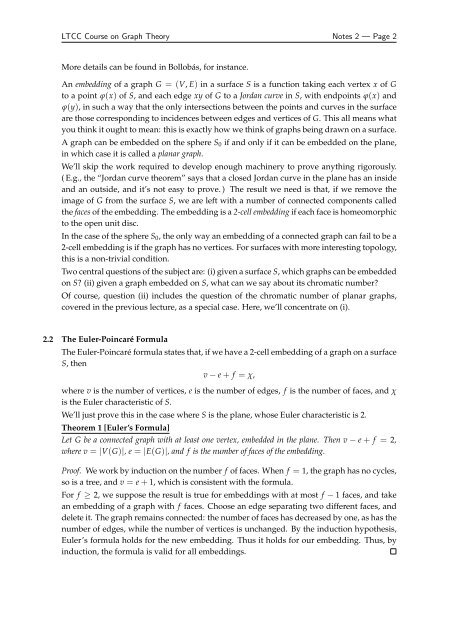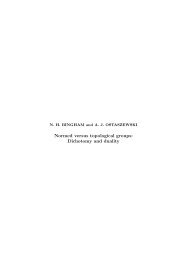LTCC Course on Graph Theory 2010/11 Notes 2 Graphs on ...
LTCC Course on Graph Theory 2010/11 Notes 2 Graphs on ...
LTCC Course on Graph Theory 2010/11 Notes 2 Graphs on ...
You also want an ePaper? Increase the reach of your titles
YUMPU automatically turns print PDFs into web optimized ePapers that Google loves.
<str<strong>on</strong>g>LTCC</str<strong>on</strong>g> <str<strong>on</strong>g>Course</str<strong>on</strong>g> <strong>on</strong> <strong>Graph</strong> <strong>Theory</strong> <strong>Notes</strong> 2 — Page 2<br />
More details can be found in Bollobás, for instance.<br />
An embedding of a graph G = (V, E) in a surface S is a functi<strong>on</strong> taking each vertex x of G<br />
to a point ϕ(x) of S, and each edge xy of G to a Jordan curve in S, with endpoints ϕ(x) and<br />
ϕ(y), in such a way that the <strong>on</strong>ly intersecti<strong>on</strong>s between the points and curves in the surface<br />
are those corresp<strong>on</strong>ding to incidences between edges and vertices of G. This all means what<br />
you think it ought to mean: this is exactly how we think of graphs being drawn <strong>on</strong> a surface.<br />
A graph can be embedded <strong>on</strong> the sphere S 0 if and <strong>on</strong>ly if it can be embedded <strong>on</strong> the plane,<br />
in which case it is called a planar graph.<br />
We’ll skip the work required to develop enough machinery to prove anything rigorously.<br />
( E.g., the “Jordan curve theorem” says that a closed Jordan curve in the plane has an inside<br />
and an outside, and it’s not easy to prove. ) The result we need is that, if we remove the<br />
image of G from the surface S, we are left with a number of c<strong>on</strong>nected comp<strong>on</strong>ents called<br />
the faces of the embedding. The embedding is a 2-cell embedding if each face is homeomorphic<br />
to the open unit disc.<br />
In the case of the sphere S 0 , the <strong>on</strong>ly way an embedding of a c<strong>on</strong>nected graph can fail to be a<br />
2-cell embedding is if the graph has no vertices. For surfaces with more interesting topology,<br />
this is a n<strong>on</strong>-trivial c<strong>on</strong>diti<strong>on</strong>.<br />
Two central questi<strong>on</strong>s of the subject are: (i) given a surface S, which graphs can be embedded<br />
<strong>on</strong> S (ii) given a graph embedded <strong>on</strong> S, what can we say about its chromatic number<br />
Of course, questi<strong>on</strong> (ii) includes the questi<strong>on</strong> of the chromatic number of planar graphs,<br />
covered in the previous lecture, as a special case. Here, we’ll c<strong>on</strong>centrate <strong>on</strong> (i).<br />
2.2 The Euler-Poincaré Formula<br />
The Euler-Poincaré formula states that, if we have a 2-cell embedding of a graph <strong>on</strong> a surface<br />
S, then<br />
v − e + f = χ,<br />
where v is the number of vertices, e is the number of edges, f is the number of faces, and χ<br />
is the Euler characteristic of S.<br />
We’ll just prove this in the case where S is the plane, whose Euler characteristic is 2.<br />
Theorem 1 [Euler’s Formula]<br />
Let G be a c<strong>on</strong>nected graph with at least <strong>on</strong>e vertex, embedded in the plane. Then v − e + f = 2,<br />
where v = |V(G)|, e = |E(G)|, and f is the number of faces of the embedding.<br />
Proof. We work by inducti<strong>on</strong> <strong>on</strong> the number f of faces. When f = 1, the graph has no cycles,<br />
so is a tree, and v = e + 1, which is c<strong>on</strong>sistent with the formula.<br />
For f ≥ 2, we suppose the result is true for embeddings with at most f − 1 faces, and take<br />
an embedding of a graph with f faces. Choose an edge separating two different faces, and<br />
delete it. The graph remains c<strong>on</strong>nected: the number of faces has decreased by <strong>on</strong>e, as has the<br />
number of edges, while the number of vertices is unchanged. By the inducti<strong>on</strong> hypothesis,<br />
Euler’s formula holds for the new embedding. Thus it holds for our embedding. Thus, by<br />
inducti<strong>on</strong>, the formula is valid for all embeddings.
















